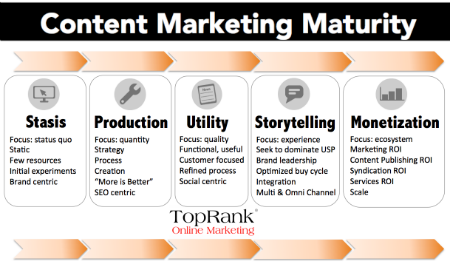 An important part of developing skills and expertise is to understand where you fall on a continuum of what’s possible and then take action to evolve and advance accordingly.
An important part of developing skills and expertise is to understand where you fall on a continuum of what’s possible and then take action to evolve and advance accordingly.
With so much digital marketing advice and information on the web, it’s easy to follow along with the latest best practices. But what about 1 or 2 years from now? How valuable would it be to anticipate the challenges and opportunities beyond the current 6 or 12 months of marketing planning?
What is in your future for content marketing?
Along these lines, I’ve been developing a model of content marketing maturity to help companies better understand where they are and where they could be with their own content marketing and as a guide for using outside content marketing services. This is especially relevant as the need to develop more integrated strategies has become the minimum to compete.
 Stasis – The focus is on the status quo. Content is created because it’s necessary or required. Press releases, new web site content when products and services are launched and the occasional blog post.
Stasis – The focus is on the status quo. Content is created because it’s necessary or required. Press releases, new web site content when products and services are launched and the occasional blog post.
Few dedicated resources are allocated to the content marketing effort and while there may be some experimentation with online content through blogging and basic social networks, the content tends to be very brand centric. SEO works independently of social media and is focused on promotion, distribution of brand messaging.
Organizations at this stage aren’t looking to grow outside of what they’re already doing until they start to see competitors overcoming them on multiple earned, owned and shared media channels.
 Production – With the realization that more content means more potential destinations for links, social shares and entry points through search visibility, companies in production mode find ways to create more content.
Production – With the realization that more content means more potential destinations for links, social shares and entry points through search visibility, companies in production mode find ways to create more content.
The “more content” approach tends to be very SEO centric, with an emphasis on creating specific, keyword focused content to justify search engine rankings.
With this predominantly SEO perspective, content is seen mostly as a link building tactics. In other words, create content so good (and promote thought social channels) that people will link to it and share on social networks.
There may be dedicated resources to content production as well as a SEO focused strategy for content and the use of social media for amplification. Processes and tools are used to make the content ideation, management, optimization, promotion and measurement efforts efficient and more effective.
A shift begins to occur where keywords are not the sole focus for determining the topics for a content plan and some emphasis is placed on mapping the customer journey through the sales cycle. Content is developed according to specific customer segments and their information needs through the buying journey.
Companies at this stage reap rewards pretty quickly as they grow their footprint on the web. However, traffic increases do not always indicate an increase in leads and sales. A common issue is a boost in search visibility and organic referrals without a corresponding increase in inquiries. Thus begins investigation into more specific opportunities from the customer point of view and more empathy with the buyer journey.
 Utility – As marketers develop their content marketing programs, processes, use of tools and skills, a shift starts to happen. Rather than letting keywords and brand messages about features and benefits drive all content planning, investments in content that empathizes with the customer and that contributes to useful experiences are made.
Utility – As marketers develop their content marketing programs, processes, use of tools and skills, a shift starts to happen. Rather than letting keywords and brand messages about features and benefits drive all content planning, investments in content that empathizes with the customer and that contributes to useful experiences are made.
As distinct customer segments are developed, with their common characteristics and information needs, content planning emphasizes answering customer questions and they move through the sales cycle. That content is optimized for search and social media discovery and promoted through multiple channels.
Content usefulness is the standard, versus simply being informative. The content or media creates value in and of itself. Imagine a buyer’s guide, or advice about how to get more value from a product or service – beyond its intended use.
Jay Baer has an entire book about creating this kind of useful content called, Youtility, that I highly recommend.
Building connections though social networks is a key component for content promotion and growing influencer relationships starts to emerge as a critical skill.
Companies that master the creation of truly useful content also attract growing social communities. This creates a robust ecosystem of content and engagement. Competition amongst mature content marketers creating utility is already tough and will only increase. In order to create a more meaningful connection with buyers and the community, marketers start to tap into more emotional appeals in their content. It’s not enough to inform, but to help buyers feel what the brand stands for.
 Storytelling – As companies come to know the questions their target customers have during the sales cycle, there are also efforts to define and put forth a brand narrative – the story a company tries to tell to a specific target audience.
Storytelling – As companies come to know the questions their target customers have during the sales cycle, there are also efforts to define and put forth a brand narrative – the story a company tries to tell to a specific target audience.
Evolving content marketing beyond features and benefits and incredible usefulness means connecting with customers on an emotional level. What better way to do that than through stories?
One way to think of this stage is that rather than just informing your customers, you’re creating experiences across channels through stories that contribute to both intellectual and emotional needs of the buyer.
Answering questions about what customers care about and how the brand wants to be known, are filtered through buying cycle analysis. Content planning identifies key brand narratives as part of the content marketing strategy and those stories drive content ideation across owned, earned, paid and shared media.
Social Networks mature at this stage and interactions with communities and influencers often contributes many of the content ideas. Along with growing influencer relationships is the growth of brand authority and subject matter experts as influencers themselves.
This is where “being the best answer” wherever customers are looking becomes a key driver for content. Also, integration of content with search, social, PR and influencer marketing is dynamic and optimized.
Evolving skills at integrating marketing messages across channels is a distinguishing feature of mature content marketers. Most companies are satisfied with the growth rates in community, engagement, customer acquisition and revenue at this stage. And yet, some will want more as they evolve their publishing capabilities and see even more opportunities to become the dominant authority in their industry.
 Monetization 360 – Of course the goal for any stage is to monetize based on how effective content is at creating awareness, interest, driving consideration and ultimately purchase. This is the core function of marketing – create awareness, educate and inspire leads and sales.
Monetization 360 – Of course the goal for any stage is to monetize based on how effective content is at creating awareness, interest, driving consideration and ultimately purchase. This is the core function of marketing – create awareness, educate and inspire leads and sales.
However, for this stage, we’re talking about the ability to monetize through customer acquisition as well as through syndication, advertising and sponsorships. In other words, the marketing content is so good, so useful and such a great experience, that it can generate revenue on its own. Few content marketing programs can or need to achieve this stage, but of course it’s fantastic when you can.
Very few companies are able to monetize content marketing in this way, but I think we’ll see a lot more in 2014 and beyond. Some of our projects are just starting to enter into this stage and I’m looking forward to being able to share case studies and examples to complement movement through these 5 stages.
Not all companies will follow a model like this, 1 2 3 of course. That’s the point of the model: to anticipate where a company wants to be with their content marketing program and to create a strategy to evolve to the stage that makes the most sense.

TopRank’s Content Marketing Maturity Model
It’s also unlikely that an entire organization’s content marketing program can be summed up as just one of these stages. But when you look at the characteristics of each stage, it’s easier to see how to align content marketing strategy to be more effective – for customers and for your business.
What do you think of this model? Do you see any similarities in your own experience as you’ve matured your content marketing capabilities?
Top image: Shutterstock


